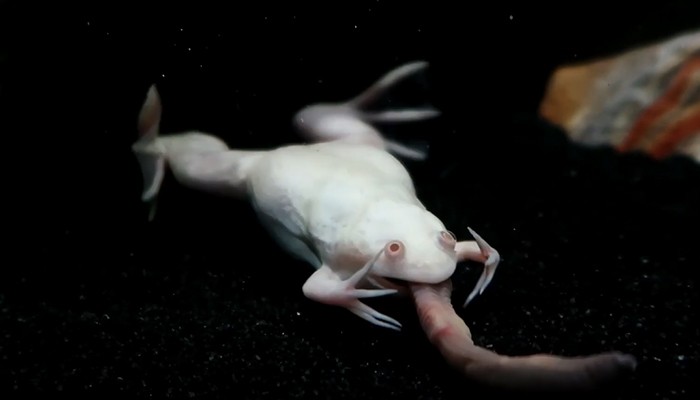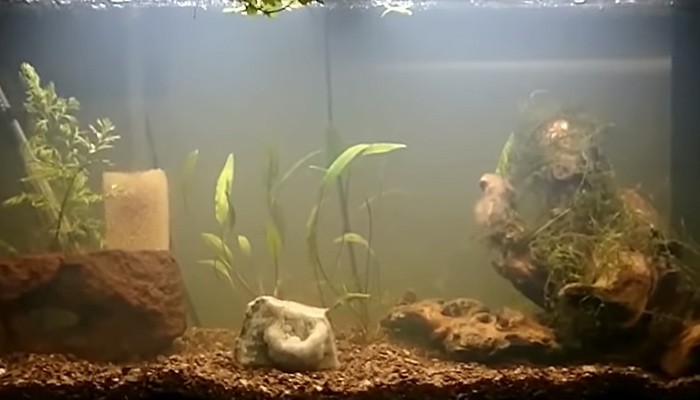6 Reasons for African Clawed Frog Not Eating (With Treatment)
The African clawed frogs are mainly aquatic frogs from the Pipidae family. They are known as clawed frogs because they have short claws on the front feet and those claws are handy to tear apart food.
The African clawed frog is a highly adaptable aquatic animal. That’s why it is an ideal aquatic pet. However, the African clawed frog is not free from diseases and other problems like all other pets. For example, it can stop eating without showing any other sign.
But why is your African clawed frog not eating? Lack of appetite can indicate different types of health problems. For instance, this frog is extremely sensitive to water. So, bad water quality makes it stop eating. In addition, other reasons are sickness, water temperature, adaptation issues, and much more.
So, let’s discuss the types of problems and their solutions.
Why Is The African Clawed Frog Not Eating?

An African clawed frog may stop eating for many reasons. So, keep reading and you will find out the actual cause behind it with the right solution.
1. Water Temperature
When it comes to the African clawed frog, water matters the most. The accurate water temperature is important for them.
Some aquatic pets live in the water at a cool temperature while others need a high temperature. So, if the water temperature is too high or too low for the African clawed frog, it may create problems i.e. not eating any food.
Typically an African clawed frog can live comfortably in the water at 72-80 degrees Fahrenheit temperature. So, make sure that the tank water keeps maintaining that temperature.
If your frog has stopped eating already, then change the water to the right temperature. If the water is cold, you can raise the temperature with a heater. (Our Pick: Orlushy Submersible Aquarium Heater)
Bonus tips: Do not keep any aquatic pet with your clawed frog if they live in too hot or too cold water.
2. Water pH Level
The pH level is also an essential matter for an African clawed frog. If your clawed frog stops eating, check the pH level of the tank water. You can check it with a pH balance test kit. (Our Pick: VIVOSUN pH and TDS Meter Combo)
One thing that you should know is that an African clawed frog is a salt-water aquatic pet. In addition, its ideal pH level is 7.0-7.5. So, more or less than this pH level may cause harm to your frog.
If your frog refuses to eat because of the unbalanced pH level in the water, then you must change the water to the exact pH level.
Besides, it would be best if you put only the saltwater animals in your frog tank.
3. Polluted Water

What we mean by polluted water is water full of harmful chemicals. The frogs are vulnerable to ammonia and nitrates. So, these are a big no for the African clawed frogs.
The tank water with toxic gasses not only causes discomfort among the frogs but also severe diseases. So, your clawed frogs may stop eating just for the high ammonia and nitrate levels in the water.
If is that so, then using RO water instead of regular water would be the wisest choice. Moreover, regular water contains many chemicals in most cases.
For testing ammonia and nitrate levels in the aquarium water, you can choose an API kit.
4. Diet
You need to keep a close eye on your clawed frog’s everyday diet. Sometimes, you need to change the food habits of your frog. For example, you regularly give bloodworms to your clawed frog. But it somehow gets tired of eating it and finally stops eating.
In this case, you can just change the food item and your frog will be fine. Besides, make sure that your frog has a balanced diet.
On the other hand, the African clawed frog also stops eating due to overeating. So, you may wonder- how often should you feed an African clawed frog? To answer this, 3 to 5 times a week is good enough for it.
5. Adaptation
You need to take care of your frog’s mental health as well as its body. If the frog stresses out about something, it may stop eating.
We have found two reasons for an African clawed frog’s stress. They are- in a new environment and are unfriendly mates.
If you have recently brought an African clawed frog to your home and suddenly notice that it is not eating, then don’t worry about it anymore. Usually, an African clawed frog needs some time to get used to the new place. So, it may not have an appetite for a few days. But it will be alright soon when it adapts to the new environment.
Moreover, if other mates in the aquarium are unsuitable for the African clawed frogs, they become stressed out and stop eating food. So, make sure that your frogs have good friends in the tank.
6. Disease
Now, you may maintain the frog tank and take proper care of your African clawed frog. But still, you may find your frog not eating and asking yourself- why is my African clawed frog dying?
Since the African clawed frog is always at a high risk of severe diseases, different bacteria, parasites, and the virus can attack at any time. In most cases, not eating is a common sign of all kinds of fatal diseases. So, take action immediately if you see your frog’s refusal to eat along with other symptoms.
Red leg, Chytridiomycosis, and Ranavirus infection are some of the fatal amphibian diseases. We will now see the symptoms and treatment of those illnesses.
Red leg
Let’s make it straight- if you notice redness on your frog’s legs and the frog is also not eating, then it may suffer from the red leg syndrome.
Now, what is red leg disease? This syndrome is very common among amphibians, especially frogs and toads. A type of bacteria called Aeromonas hydrophila is responsible for this disease. But viruses or fungi can also cause a similar syndrome.
The red-leg bacteria attacks easily in poor-quality water. Besides, your frog will show certain symptoms. Those are-
- Lethargy
- Anemia
- Fast weight loss
- Ascites
- Not eating.
If you notice these symptoms, then consult with a vet immediately. The vet will first diagnose the clawed frog by testing blood or finding out the presence of bacteria in different organisms.
Treatment
Take your African clawed frog to a vet as soon as possible. After diagnosing it, your vet will start the treatment according to the cause of the disease. For example, if the red leg syndrome is caused by the Aeromonas bacteria, then the doctor may prescribe some strong antibiotics to cure this disease. Follow the prescription properly.
Prevention
Since polluted water is the main cause of red leg syndrome disease, then maintaining a clean tank is crucial for your frog’s health. So, you have to change the water from time to time and keep the aquarium hygienic all the time.
Thus you can prevent this disease. Also remember, prevention is easier than dealing with the disease.
Chytridiomycosis
Chytridiomycosis is a chronic disease caused by the chytrid fungus. It is capable enough to destroy your pet frog’s life.
The most common sign that your African clawed frog suffers from the chytrid fungus is skin-shedding. Besides, it completely stops eating. So, let’s see the symptoms below-
- Lethargy
- Anorexia (loss of appetite)
- Unusual movement of the eye pupils
- Hyperemia
- Abnormal behavior.
If you notice these signs, do not hesitate to contact a vet.
Treatment
Chytridiomycosis is a contagious disease. So, you have to take immediate action to save your little frog friend.
- Separate the affected frog from the other animals in the aquarium.
- Put it in a different tank with water above 32 degrees centigrade temperature since it helps to kill the chytrid fungus.
- Take your frog to a vet as soon as possible.
- The vet may prescribe benzalkonium chloride or 75% of diluted hydrogen peroxide at the early stage of the disease. (our pick: McKesson Benzalkonium Chloride)
- The vet may also recommend a bath solution such as topical itraconazole (0.01%) to remove the fungus infection from the body. (our pick: Terrasil Anti-fungal Treatment)
Prevention
Prevention is crucial to avoid the chytrid fungus in your frog tank. So, read the instructions below-
- Remove all kinds of dead plants or waste organs from the aquarium.
- Make sure that the temperature and the pH level remain accurate in the tank water.
- Vacuum the substrate with a gravel cleaner. (Our pick: Hygger Aquarium Gravel Cleaner)
- Sanitize the aquarium properly after an aquatic animal dies due to a fungal infection.
Ranavirus Infection
Another reason why your African clawed frog is not eating can be the ranavirus. It is not only contagious but also hard to diagnose. Typically, it is found post-mortem after the death of the frog.
However, you can notice certain symptoms.
- Lethargy
- Not eating
- Skin sores
- Skin redness
- Poor eyesight
- Bleeding
If you notice these signs, ask for help from a nearby vet. He will help you to diagnose your African clawed frog.
Treatment
The ranavirus is so fatal that it can destroy the entire population of a pond or aquarium. Besides, no scientists have yet discovered any cure for this disease.
It is sad but true- if the ranavirus attacks your African clawed frog, the chance of survival is little. What’s more, the affected population recovered after several years.
If this virus once attacks, you have nothing to do except expect that it will not wipe out the whole population.
Prevention
Although there is no effective way to prevent this virus, you can maintain the hygiene of your frog tank. Besides, if one frog dies, don’t just throw it away. Instead, burn or bury it to prevent further contagion.
Frequently Asked Questions
How Long Can An African Clawed Frog Survive Without Eating?
The African clawed frogs don’t need to eat every day. However, if it gets sick, it usually stops eating. Now you may wonder how long it can survive without eating. On average, an African clawed frog still can survive for 4-5 days without eating.
How Often Do You Have To Feed An African Clawed Frog?
The African clawed frogs are not picky about food. They eat anything. But overeating also causes obesity. So, feeding your African clawed frog 3-5 times weekly is enough.
How Do I Know If My African Clawed Frog Is Dying?
Some certain symptoms will tell you that your African clawed frog is suffering from a fatal disease and soon it will die. Those common signs are- lethargy, discoloration, bleeding, not eating, and abnormal behavior. So, take immediate action if you see these signs.
Conclusion
We all care about our pet friends. Moreover, if it’s an African clawed frog then we have to be extra careful. Since its body is sensitive, it can get affected by fungus, bacteria, or viruses at any time.
Besides, it stops eating sometimes. But why is your African clawed frog not eating? Water problems, adaptation issues, and diseases are some common reasons.
If you notice that your clawed frog stops eating, then closely observe it and find out the exact reason. After that, make the necessary arrangements to make your frog eat healthily.
So, we hope that this article will help you find out the reasons behind not eating and the solutions.
- Will Axolotl Jump Out Of Tank – Preventing Escapes & Ensuring Your - January 7, 2026
- How Do Axolotls Mate – A Comprehensive Guide To Successful Breeding - January 7, 2026
- Axolotl Curled Tail – Understanding, Preventing, And Nurturing Healthy - January 7, 2026
